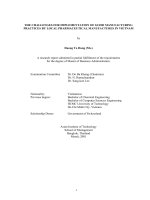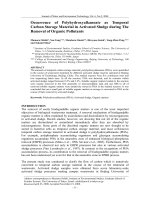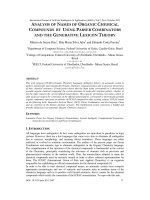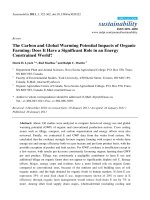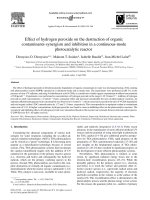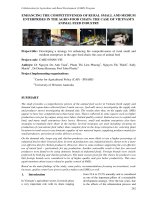Extent the adoption of organic farming practices by farmers in crop production
Bạn đang xem bản rút gọn của tài liệu. Xem và tải ngay bản đầy đủ của tài liệu tại đây (143.83 KB, 4 trang )
Int.J.Curr.Microbiol.App.Sci (2019) 8(8): 2744-2747
International Journal of Current Microbiology and Applied Sciences
ISSN: 2319-7706 Volume 8 Number 08 (2019)
Journal homepage:
Original Research Article
/>
Extent the Adoption of Organic Farming Practices
by Farmers in Crop Production
Shivam Singh1, S. K. Singh2 and D. V. Singh3*
1
2
Department of Agricultural Extension R.B.S. College, Bichpuri, Agra, India
SMS. Agricultural Extension, Krishi Vigyan Kendra, Awagarh, Etah (U.P.), India
3
Krishi Vigyan Kendra, Tonk, Rajasthan, India
*Corresponding author
ABSTRACT
Keywords
Adoption, Organic
farming
Article Info
Accepted:
22 July 2019
Available Online:
10 August 2019
The present study was conducted in Awagarh block of Etah district of Uttar
Pradesh to find out the extent of adoption of organic farming practices by
farmers in crop production. Study revealed that majority of the farmers
60.00 per cent found to overall medium adoption group followed by low
adoption group 22.00 per cent and high adoption of organic farming
practices 18.00 per cent respectively. The adoption on different types of
organic farming practices, 30.00 per cent farmers had completely adopted
the weed control method followed by use of bird pitcher 24.00 per cent, use
of neem oil for insect control 23.00 percent, use of recommended bio
fertilizer, vermi compost and FYM 21.00 per cent etc. There were 12
components of organic farming practices and the farmers were categorized
into three categories (no, partial, complete) as per adoption of particular
component.
Introduction
In India more than 70 per cent of the total
population is living in the villages. This
population is dependent on agriculture and
allied activities for its livelihood. Agriculture
is the primary sector of Indian economy.
Hence, agriculture has been the back bone of
Indian economy. Like India, in Uttar Pradesh
farming is also the major source of livelihood
and self-employment of near about 80 per cent
of the population living in rural areas.
(Badgujjar 2012). It is true that the increasing
use of fertilizers and pesticides at high rates
has boosted agricultural production in the
country. But it has also caused adverse impact
on soil and water, as well as environment.
Long term continuous use of high doses of
chemical fertilizers alone badly affects the soil
physical, chemical and biological properties.
Rainfall and excess use of irrigation water
cause the alkalinity or acidity of the soils. The
pesticides and fertilizers mixed with rain or
irrigated water and contaminate rivers, wells,
2744
Int.J.Curr.Microbiol.App.Sci (2019) 8(8): 2744-2747
lakes, etc. and also leak into the drainage
system which goes in to the drinking water
contaminating the environment. The heavy
metals present in the fertilizers, pesticides and
sewage sludge leach into ground water.
(Kaushik, K.K., 1997).
The global concerns of safe foods have
introduced the concept of organic farming.
Organic agriculture is an eco-friendly
production system that promotes and enhances
biodiversity, biological cycles and biological
activities. The principle is based on minimal
use of off-farm inputs and management
practices that help to maintain and enhance
ecological balance. Organic agriculture is
chemical free. Producing organically is a
commitment to a system which ensures that
healthy, nutritious food can be produced year
after year. The primary goal of organic
farming is health and productivity of
interdependent communities of soil life,
animals and for millions of human beings.
(Lukas, M. and Cahn, M., 2008)
“Organic farming is a production system that
avoids or largely excludes the use of
synthetically
compounded
fertilizer,
pesticides, growth regulators and livestock
feed additives. Organic farming systems rely
to the maximum extent on crop rotations, crop
residues, animal manures, legumes, green
manures, off-farm organic wastes, and aspects
of biological pest control to maintain soil
productivity and tilt, to support plant nutrients
and control insects, weeds and other pests”.
(Kanel, 2005). In Uttar Pradesh, organic
farming is being implemented under the
guidance of a team of experts consisting of
scientists,
environmentalists
and food
management personnel. Nutrients to the crops
are provided through green manuring,
composts, phospho-composts and fermented
preparations prepared from cow dung and
urine. Pests are managed through the use of
Neem and cow urine based fermented
preparations. Eight different ways of
composting are recommended in Uttar
Pradesh. They are the Indore method, NADEP
compost, NADEP phosphor-compost, Vermi
compost, Bhabhut amrit pani, Amrit
sanjeevani, Pitcher khad, Biogas slurry, Green
manures and Bio fertilizer. (Kushwaha, 2003)
Materials and Methods
The present study was conducted in Awagarh
block of Etah district of Uttar Pradesh to find
out the extent of adoption of organic farming
practices by farmers in crop production. One
block namely Awagarh was selected
purposively having maximum use of organic
farming practices in crops. Hence, the present
study has been designed to explore the level of
adoption of organic farming practices in Etah
district of Uttar Pradesh with specific
objective. Similarly a list of farmers adopting
organic farming practices of five selected
villages was prepared and from the list 100
farmers was selected on the basis of random
sampling method. The collected data were
tabulated and presented in the form of tables,
graphs and other needed form as per the stated
objective.
Results and Discussion
Level of adoption of organic farming
practices
The data presented in table 1 reveals that
majority of the farmers 60.00 per cent found
to overall medium adoption group followed by
low adoption group 22.00 per cent and high
adoption of organic farming practices 18.00
per cent respectively.
Thus, it may be concluded that in study area,
most of the farmers were found to overall
medium adoption of organic farming practices
group (60%) followed by low and high
adoption of organic farming practices.
2745
Int.J.Curr.Microbiol.App.Sci (2019) 8(8): 2744-2747
Table.1 Distribution of farmers according to their overall extent of level of adoption in respect of
organic farming practices
S. No.
1.
2.
3.
Categories & Scores
Low (1-8)
Medium (9-16)
High (17-24)
Total
Frequency
22
60
18
100
Percentage
22.00
60.00
18.00
100.00
Table.2 Distribution of farmers according to their component wise adoption of
Organic farming practices
S. No.
1.
2.
3.
4.
5.
6.
7.
8.
9.
10.
11.
12.
Organic farming practices
Use of summer deep ploughing
Use of crop rotation with pulses for N- fixation
Use of intercropping with pulses for N- fixation
Use of seed treatment
Use of insect resistance variety
Use of recommended bio fertilizer, vermi
compost and FYM
Use of trap for insect control
Use of Bird Pitcher in the crop field for sitting
of bird
Use of chilli and garlic solution for insect
control
Use of neem oil for insect control
Use of weed control method
Use of bio insecticide for insect control
Overall average
The possible reason for the above findings
could be that those practices which were easy
to adopt and required less skill were fully
adopted by the respondents.
While, those practices which required more
knowledge and handling skills were adopted
by less number of respondents or the
respondents were refused to adopt these
components of organic farming practices.
The data in the table 2 reveals that as regard
to the adoption on different types of organic
farming practices, 30.00 per cent farmers had
No
20
20
24
29
28
20
Level of Adoption
Partial
Complete
62
18
61
19
60
16
61
10
60
12
59
21
29
18
60
58
11
24
30
60
10
19
13
20
22
58
57
60
60
23
30
20
18
completely adopted the weed control method
followed by use of bird pitcher 24.00 per cent,
use of neem oil for insect control 23.00
percent, use of recommended bio fertilizer,
vermi compost and FYM 21.00 per cent etc.
There were 12 components of organic
farming practices and the farmers were
categorized into three categories (no, partial,
complete) as per adoption of particular
component.
It is evident from the study that the highest
level of adoption was found in respect of use
2746
Int.J.Curr.Microbiol.App.Sci (2019) 8(8): 2744-2747
of weed control method (rank Ist) followed by
use of bird pitcher in the crop field for sitting
of bird (rank IInd), use of neem oil for insect
control (rank IIIrd), use of recommended bio
fertilizer, vermi compost and FYM (rank
IVth), use of bio insecticide for insect control
(rank Vth) respectively.
Higher percentage of the farmers were found
to overall medium adoption of organic
farming practices group followed by low and
high adoption of organic farming practices.
The possible reason for the above findings
could be that those practices which were easy
to adopt and required less skill were fully
adopted by the respondents.
While, those practices which required more
knowledge and handling skills were adopted
by less number of respondents or the
respondents were refused to adopt these
components of organic farming practices.
References
Badgujjar, M.K. (2012). A study on knowledge
and adoption of organic farming practices
among the farmers in Sehore District
(M.P.). M.Sc. (Ag.) Thesis, R.V.S.K.V.V.
Gwalior.
Kanel, M.S. (2005). A study on knowledge about
organic farming practices possessed by the
farmers and their adoption in Dhar district,
Madhya Pradesh. M.Sc. (Ag.) Thesis,
J.N.K.V.V. Jabalpur.
Khan, Md. Suleman; T. Krishna, and P. Punna.
Rao, (2002). Adoption pattern of Eco
friendly technology by rice growers. Agril.
Extn. Review, March-April, 22-25.
Osari, D. (2011). A Study on Knowledge and
Adoption of Organic Farming Practices by
Farmers in Indore District of Madhya
Pradesh. M.Sc. (Ag.) Thesis, R.V.S.K.V.V.
Gwalior.
Ramesh, P. and S. Govind (2001). Adoption of
organic farming practices in paddy. Indian
J. Extn. Edu., 37(3&4): 91-94
Ranaganath, A.D.; V. Veerabhadriah, and K.C.
Lalitha (2001). Adoption of organic
farming practices by small farmers. Agil.
Extn. Review. pp: 3-6.
Ravankar, H.N.; R.H. Patil; N.B. Mohod and P.W.
Desmukh (2000). Effect of organic farming
on yield and soil fertility under cottonsorghum-soybean. P.K.V. Res. J. 24(2): 8083.
Saxena, K.K and R.L. Singh (2000). Adoption of
organic farming practices by farmers of
Malwa Region. Maharastra Journal of
Extn. Edu. 19: 53-55.
Saxena, K.K and T.S. Kushwah (2004). Adoption
of organic farming practices. 4(1&2): 34.
Sharma, V.K. (1986). A comparative study of the
adoption of improved package of practices
of Rice and Wheat crop in panagar block.
M.Sc. (Ag.) Thesis, J.N.K.V.V. Jabalpur.
Sidram (2008). Analysis of organic farming
practices in pigeonpea in Gulbarga district
of Karnataka state. M. Sc. (Agri.) Thesis,
Univ. Agril. Sci., Dharwad.
Singh, V.K. (2005). A study on behaviour of
farmers in relation to organic farming
practices in selected block of Rewa district,
M.P. M.Sc. (Ag.) Thesis, J.N.K.V.V.
Jabalpur.
Sriram, N. and A. Palaniswamy (1999). Farmers’
extent of adoption of eco-friendly
agriculture practices in cotton cultivation.
Journal of Extension Education, 10(1):
2318-2323.
How to cite this article:
Shivam Singh, S. K. Singh and Singh D. V. 2019. Extent the Adoption of Organic Farming
Practices By Farmers in Crop Production. Int.J.Curr.Microbiol.App.Sci. 8(08): 2744-2747.
doi: />
2747
